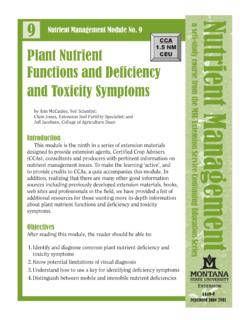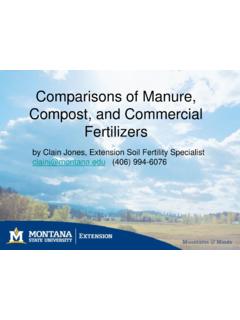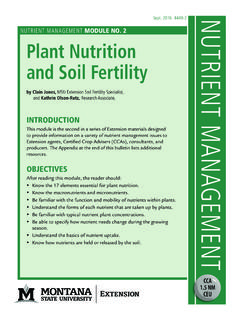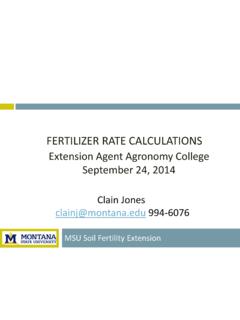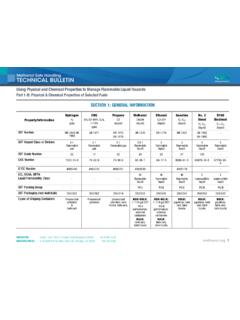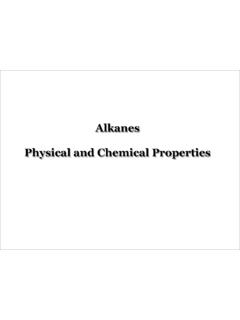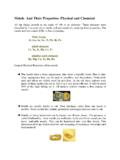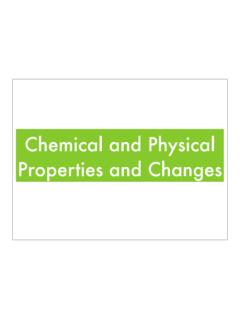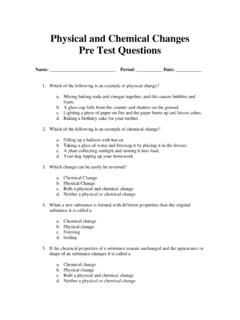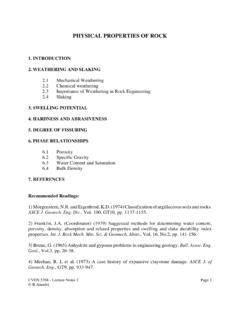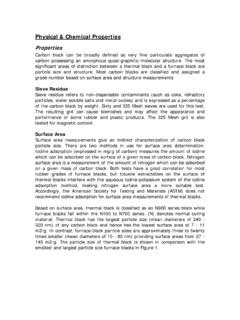Transcription of Soil Water - Land Resources and Environmental …
1 Introduction This is the first module within the soil and Water (SW) Management series provided by the Montana State University Extension Service and Rocky Mountain Certified Crop Adviser (CCA) program. Used in conjunction with the Nutrient Management (NM) modules, this series is designed to provide useful, applicable information for Extension agents, CCAs, consultants, and producers within Montana and Wyoming on practices used to effectively manage soil and Water Resources . To enhance the learning objective and provide CCAs with continuing education units (CEUs) in soil and Water Management, a quiz accompanies this module. Also, realizing there are many other sources of information pertaining to soil erosion, we have included an appendix at the end of the module listing additional Resources and contacts. This module covers the following Rocky Mountain CCA soil and Water Management Competency Areas: basic soil properties , Water and solute movement and plant/ Water relations.
2 ObjectivesAfter reading this module, the reader should be able to: List basic soil properties and understand the relationships between properties Understand how soil texture affects Water and plant relations Recognize how management practices influence soil structure, porosity and soil organisms Understand relationships between soil chemical properties to exchange capacity, pH and salt-affected soils Describe the relationship between soil organic matter and basic soil propertiesBackground As the first module within the soil and Water Management (SW) series, this module introduces basic physical , chemical and biological properties that affect agricultural soils. Processes such as fertility, Water and solute movement and retention, and organic matter accumulation and decomposition are all affected by soil properties . Some of the properties presented in this module have already been discussed in Nutrient Management (NM) Modules 1 15 (see Appendix), and many will be expanded upon in subsequent SW modules.
3 1A self-study course from the MSU Extension Service Continuing Education SeriesSoil& Water MANAGEMENT MODULE 11 SWBASIC soil PROPERTIESby Ann McCauley, soil Scientist, Clain Jones, Extension soil Fertility Specialist and Jeff Jacobsen, soil ScientistS O I L & W AT E R M A N A G E M E N TCCACEU4481-1 JAN. 20052 Module 1 Basic soil PropertiesSoil physical properties soil is comprised of minerals, soil organic matter (SOM), Water , and air (Figure 1). The composition and proportion of these components greatly influence soil physical properties , including texture, structure, and porosity, the fraction of pore space in a soil . In turn, these properties affect air and Water movement in the soil , and thus the soil s ability to function. Although SOM comprises a relatively small portion of soil , typically only 1 4% in Montana and Wyoming agricultural soils, it plays a key role in many soil processes (NM 8) and will be discussed throughout the module.
4 soil Development and HorizonsSoil development is caused by climate and living matter acting upon parent material (weathered mineral or organic matter from which the soil develops), as conditioned by topography, over time (Brady and Weil, 2002). The result of these processes is a soil profile of varying layers, or horizons, each with distinct texture, structure, color and other properties . Most agricultural soils are grouped into four main master horizons: O, A, B, and C (Figure 2). Various subcategories may occur within these horizons and are designated by a lower case letter following the master horizon capital letter ( , Ap or Bt). The O horizon is an organic layer above the mineral soil that consists of fresh or partially decomposed organic material and is most common in forested soils. The A horizon is the mineral soil surface layer and is the horizon most impacted by biological and human activity. It usually has the highest percentage of SOM, which often results in it being darker in color than the rest of the profile (NM 8).
5 Below the A horizon will be either an E horizon, usually not present in grassland/ agricultural soils, or a B horizon, the horizon of accumulation. Material from the A (or E) horizon, such as clay and carbonates, leach downward and accumulate in the B horizon. The C horizon represents the weathered parent material. Bedrock (designated by R) or a deep accumulation of materials deposited by wind, Water , glaciers or gravity often lies below the C horizon. Not all soils will have every horizon or subhorizon present. For instance, a poorly developed soil may lack a strongly defined B horizon or highly eroded lands may have a thin, or nonexistent, A horizon. soil TextureSoil texture can have a profound effect on many other properties and is considered among the most important physical properties . Texture is the proportion of three mineral particles, sand, silt and clay, in a soil . These particles are distinguished by size, and make up the fine mineral fraction (Table 1).
6 Particles over 2 mm in diameter Figure 1. The four components of soil . Minerals and SOM make up the solid fraction, whereas air and Water comprise the pore space fraction. A typical agricultural soil is usually around 50% solid particles and 50% pores. (Adapted from Brady and Weil, 2002) Figure 2. A general soil 1. Diameter and approximate size of four soil ParticleDiameter (mm)Approximate SizeGravel> Clay< to naked eye Module 1 Basic soil Properties3(the coarse mineral fraction ) are not considered in texture, though in certain cases they may affect Water retention and other properties . The relative amount of various particle sizes in a soil defines its texture, , whether it is a clay, loam, sandy loam or other textural category (Figure 3). Texture is the result of weathering, the physical and chemical breakdown of rocks and minerals.
7 Because of differences in composition and structure, materials will weather at different rates, affecting a soil s texture. For example, shale, an easily weathered rock, forms clay-rich soils, whereas granite, a slow weathering rock, usually forms sandy, coarse soils. Since weathering is a relatively slow process, texture remains fairly constant and is not altered by management practices. soil Colloids soil colloids refer to the finest clay and SOM particles in a soil . Colloids are an important soil fraction due to properties that make them the location of most physical and chemical activity in the soil . One such property is their large surface area. Smaller particles have more surface area for a given volume or mass of particles than larger particles (Figure 4). Thus, there is increased contact with other colloids and with the soil solution. This results in the formation of strong friction and cohesive bonds between colloid particles and soil Water , and is why a clay soil holds together better than a sandy soil when wet.
8 chemical colloidal properties will be discussed further in the module. soil StructureSoil structure is the arrangement and binding together of soil particles into larger clusters, called aggregates or peds. Aggregation is important for increasing stability against erosion, for maintaining porosity and soil Water movement, and for improving fertility and carbon sequestration in the soil (Nichols et al., 2004). Granular structure consists of loosely packed spheroidal peds that are glued together mostly by organic substances (Figure 5). Granular structure is characteristic of many A horizons, particularly those with high SOM content and biological activity. Larger peds, in the form of plates, blocks, or prisms, are commonly associated with the B horizon and are formed via shrink-swell processes and adhesive substances (Gardiner and Miller, 2004). As soil swells (wets or freezes) and then shrinks (dries or thaws), cracks form around soil masses, creating peds.
9 Peds are held together and in place through the adhesion of organic substances, iron oxides, clays or carbonates. Cracks Figure 5. Topsoil exhibiting granular Sand% Clay% SiltClayClay LoamSandy Clay LoamSandyClaySilty ClaySlity Clay LoamSilt LoamSiltLoamSandyLoamLoamy SandSand10101020202030303040404050505060 6060707070808080909090 Figure 3. Textural triangle showing a soil s textural class according to the percentage of sand, silt and clay it contains. Note that a solid with 25% clay and 40% silt is large particleTwo smaller particlesNewly exposedsurface areaFigure 4. Illustration of surface area. The smaller particles have a greater total surface area than the one larger 1 Basic soil properties Figure 7.
10 A soil at saturation, FC and PWP. At saturation, the soil is holding all the Water it can. FC is approximately half the Water content of saturation. Water content at PWP varies and will depend on the plants ability to withstand drought. Note that FC - PWP = PAW. (Adapted from Brady and Weil, 2002)and channels between peds are important for Water , air, and solute transport and deep Water drainage. Finer soils usually have a stronger, more defined structure than coarser soils due to shrink/swell processes predominating in clay-rich soils and more cohesive strength between particles. soil PorosityMany important soil processes take place in soil pores (the air or Water -filled spaces between particles). soil texture and structure influence porosity by determining the size, number and interconnection of pores. Coarse-textured soils have many large (macro) pores because of the loose arrangement of larger particles with one another.
